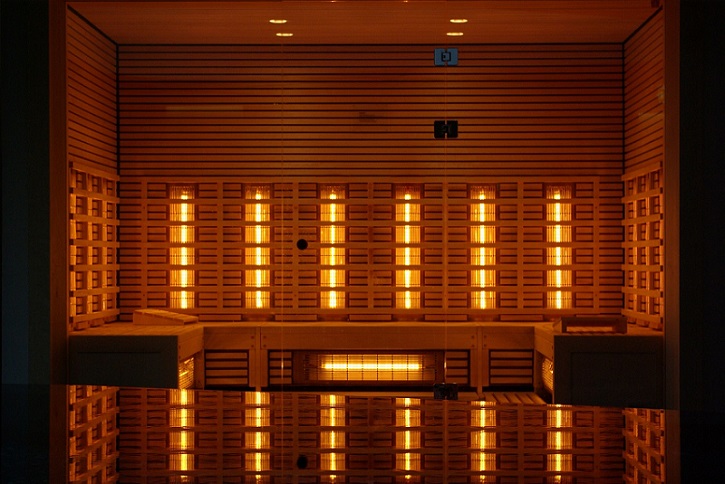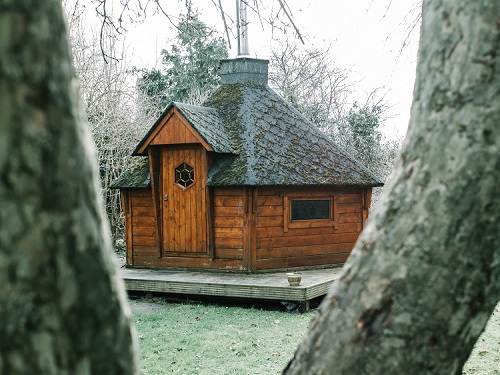Owning a sauna can be very enticing: A warm sanctuary, where you can escape the stresses of daily life and embrace the soothing heat. However, choosing the right sauna for your needs can be a heated debate in itself. In this Infrared sauna vs Traditional sauna article, we compare the traditional sauna and the modern infrared sauna.
These two sauna options offer unique experiences, benefits, and considerations, and by the end of our exploration, we hope you’ll have a clearer picture of which one is for you.
Infrared Sauna vs Traditional Sauna
| Traditional Sauna | Infrared Sauna | |
| Heating method | Conduction/Convection | Radiation |
| Heater Types | Wood-fired, Electrical, Gas | Infrared (Electrical) |
| Temperature | Can heat above 85 °C (185 °F) | 50 °C to 65 °C (120 °F to 150 °F) |
| Energy Requirements | More power (up to 4.5 – 6 kW and higher) | Low power (about 1.6 kW) |
| Humidity | High Humidity | Low humidity |
| Typical Size | 2-4 people or more | 1-2 people |
| Maintenance | Higher Maintenance | Lower Maintenance |
| Initial Cost | Higher initial costs | More affordable upfront |
*Note: This is due to construction costs, but traditional saunas can be also affordable through DIY saunas and barrel saunas. Check them out!
Understanding Infrared Saunas

Unlike traditional saunas, which rely on heating the air around you, infrared saunas utilize special infrared heaters that emit infrared waves. These waves then directly penetrate the skin and warm your body from within.
How Infrared Saunas Work
When you step into an infrared sauna, the infrared waves emitted by the heaters gently infiltrate your skin, much like the warming rays of the sun. This penetration, while maintaining a comfortable and lower air temperature, induces a deep sense of warmth throughout your body.
Traditional Saunas: The Basics

Traditional saunas utilize heated rocks or a stove to create high temperatures and humidity within an enclosed room.
How Traditional Saunas Generate Heat
Traditional saunas rely on various heating methods:
Wood-Fired Heaters
Many people prefer the authenticity of wood-fired heaters with the aromatic scent of burning wood adds to the ambiance. These heaters heat the sauna room by transferring heat to a stack of carefully arranged rocks.
Read More: How Does a Wood Fired Sauna Work?
Electric Heaters
Electric heaters are a modern twist on traditional saunas, offering precise temperature control and convenience. These heaters use electric elements to warm the sauna room.
Gas Heaters
Gas heaters are another option for heating traditional saunas. They efficiently produce heat and are suitable for saunas of different sizes, and are a cheaper alternative to electric heaters
Heat and Comfort

Infrared Saunas: Infrared saunas provide a milder and more gentle heat experience, with temperatures typically ranging from 50°C to 65°C. Additionally, these saunas tend to have lower humidity levels, creating a dry heat environment.
Traditional Saunas: Traditional saunas have higher temperatures and steam. Here, temperatures often soar above 71°C, with steam as an integral part of the sauna experience.
Why Choose Lower Temperatures in Infrared Saunas?
The gentle heat of infrared saunas can be appealing to individuals who find extreme heat challenging to tolerate, namely for these reasons:
Comfort: The lower temperatures in infrared saunas, coupled with their dry heat, create a more comfortable and tolerable environment. This makes them an excellent choice for those who may be sensitive to or uncomfortable with the intense heat of traditional saunas.
Prolonged Sessions: The milder heat in infrared saunas allows for longer, more leisurely sessions. This extended exposure to comfortable warmth can enhance relaxation and the therapeutic benefits of the sauna.
Why Opt for Higher Temperatures and Steam in Traditional Saunas?

Intense Heat: Traditional saunas, with their higher temperatures, provide an invigorating heat that some people find deeply satisfying. The sensation of heat enveloping your body can create a unique sense of cleansing and rejuvenation.
Steam: Steam is an integral part of the traditional sauna experience. Pouring water on hot rocks creates bursts of steam that instantly elevate the humidity, intensifying the heat and the feeling of purification. This practice, enjoyed by the senses, is what people keep going back to in the traditional sauna experience.
Sauna Maintenance

Infrared Saunas: Infrared saunas generally have lower maintenance needs. Regular cleaning of the heaters and control panel, along with occasional checks for loose wiring, is usually sufficient. The absence of steam and wood components simplifies maintenance.
Traditional Saunas: Traditional saunas, especially those with wood-fired stoves, may require more frequent maintenance. The sauna stove and chimney should be inspected periodically for safety and efficiency. Wood saunas also need occasional sealing to prevent moisture damage.
Infrared sauna vs Traditional Sauna Cost Comparison
Initial Costs
Infrared Saunas are often more budget-friendly upfront. They typically come as ready-made units that can be easily assembled. The installation is relatively straightforward, and they don’t require the construction of a dedicated space. This affordability makes them an attractive choice for many.
Traditional Saunas, especially those with custom-built wood-fired stoves, can be pricier due to the construction involved. Creating a dedicated sauna room, proper insulation, and ventilation can add to the initial costs. However, the timeless allure of traditional saunas may outweigh the investment for some enthusiasts.
Long-Term/ Operational Costs
Infrared saunas are generally more energy-efficient. They require less power to operate due to their lower operating temperatures. This can translate into cost savings in the long run, as your energy bills won’t be significantly impacted.
Traditional Saunas tend to consume more energy to maintain their higher temperatures. The heating equipment, whether wood-fired, electric, or gas, can contribute to higher operational costs over time. It’s essential to factor in ongoing energy expenses when considering a traditional sauna.
However, what if we tell you there is an affordable way to enjoy a traditional sauna?
Barrel Saunas: The Affordable Path to Tradition

Barrel saunas represent a combination of traditional sauna comfort and a modern sauna’s affordability.
These saunas are designed in a distinctive barrel shape that not only adds a touch of rustic charm to your space but also contributes to their efficiency. The curved design allows for efficient air circulation, ensuring that the heat is distributed evenly throughout the sauna.
What sets barrel saunas apart is their cost-effectiveness; they provide the authentic sauna experience without the high price tag often associated with traditional saunas.
Barrel Sauna Advantages
These kits come with all the necessary components neatly packaged, ready for assembly. The beauty of DIY sauna kits lies in their simplicity; with clear instructions and minimal tools required, individuals can have a fully functional sauna within hours to days, depending on the model and the installer’s pace.
This hands-on approach not only saves money but also adds a sense of accomplishment as you see your sauna take shape. What’s more, many suppliers offer the option to have these kits delivered directly to your doorstep, eliminating the need for additional expenses on building materials or construction.
What Should You Choose? Personal Preferences and Goals

Ultimately, the choice between infrared and traditional saunas is a deeply personal one, guided by your unique preferences and wellness objectives.
Heat Tolerance
Consider your tolerance for heat. If you prefer milder, more gentle warmth, an infrared sauna may be your ideal choice. On the other hand, if you relish the intense heat and steamy ambiance, traditional saunas may be more appealing.
Space Availability
Think about the space you have available. Infrared saunas are versatile and fit well in smaller rooms, making them suitable for homes with limited space. Traditional saunas, with their larger footprint. Although if you desire to share the sauna with friends and family, having a large sauna will be worth it.
Specific Objectives
Your goals should also guide your choice. If you’re seeking the potential benefits of deeper tissue penetration, infrared saunas may align with your objectives.
Traditional saunas, with their higher temperatures and high humidity, offer a unique experience that people find invigorating. Also, the social aspect of saunas are best enjoyed with a traditional sauna!
Wrapping Up
And that’s it for Infrared sauna vs Traditional sauna. Traditional saunas offer the timeless charm of high heat, steam rituals, and tradition, providing an authentic sauna experience. On the other hand, infrared saunas, with the gentle warmth and convenient experience provide a new twist on taking a sauna, an age-old tradition.
If you find yourself drawn to the traditional sauna experience but are mindful of your budget, why not explore an alternative at Shym Saunas? We offer a wide range of barrel saunas and DIY sauna kits that bring comfort of traditional saunas to your doorstep. Visit our shop now!



